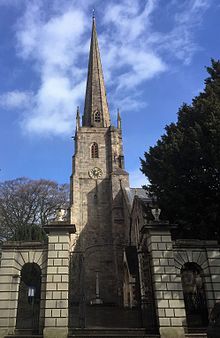St Mary's Priory Church, Monmouth
| St Mary's Priory Church, Monmouth | |
|---|---|

Entrance to the church on Whitecross Street
|
|
| 51°48′48″N 2°42′50″W / 51.8132°N 2.714°WCoordinates: 51°48′48″N 2°42′50″W / 51.8132°N 2.714°W | |
| Location | Monmouth, Monmouthshire |
| Country | Wales |
| Denomination | Anglican |
| Website | Monmouth Parishes: St Mary's Priory Church |
| History | |
| Founder(s) | Withenoc (or Gwethenoc) |
| Dedication | Saint Mary the Virgin |
| Architecture | |
| Status | Church in Wales parish church |
| Functional status | Active |
| Heritage designation | Grade II* |
| Designated | 27 June 1952 |
| Architect(s) | |
| Specifications | |
| Materials | Old Red Sandstone (tower) |
| Administration | |
| Parish | Monmouth |
| Deanery | Newport and Monmouth |
| Diocese | Diocese of Monmouth |
| Clergy | |
| Vicar(s) | Reverend David McGladdery |
| Laity | |
| Director of music | Ian Dollins |
| Churchwarden(s) | Jennifer Napier |
St Mary's Priory Church, in Whitecross Street, Monmouth, Monmouthshire, Wales, is an Anglican church founded as a Benedictine priory in 1075. The current church dates mostly from the 18th and 19th centuries. It was designated a Grade II* listed building in 1952. It is one of 24 buildings on the Monmouth Heritage Trail.
The priory church was founded by Withenoc (or Gwethenoc), a Breton who became lord of Monmouth in 1075 after Roger de Breteuil, the son of William fitzOsbern, was disgraced for allowing his sister to wed the Earl of Norfolk against the wishes of King William. There is evidence in the Book of Llandaff of an earlier 8th century Celtic church at Aper Menei, which is interpreted to be Monmouth, and it has been tentatively suggested that this may have been on the site of the later priory.
The priory was granted to the Abbey of St Florent at Saumur, and was consecrated in the presence of William fitzBaderon in 1101. It was extended and became the parish church later in the twelfth century. Few traces of the early building remain, other than a short section of Norman wall.
The tower, of Old Red Sandstone with three stages, dates from the fourteenth century. The building deteriorated after the Dissolution of the Monasteries in 1536. By 1730, the church was described as ruinous and decayed. Significant rebuilding was undertaken in 1736-7 by Francis Smith of Warwick, who constructed an entirely new nave, but this work has also mostly gone. A new spire rising to a height of 60 metres (200 ft) was provided in 1743, to the design of Nathaniel Wilkinson of Worcester. In the late nineteenth century, the church was almost completely rebuilt by George Edmund Street. Street's structural report of 1879 was dismissive: "it might be said to have no style at all, at any rate it [is] extremely unattractive and uninteresting." His original intention was complete demolition and rebuilding, but the estimated cost of £22,000 was too high and he was limited to reconstruction, in which the tower and the steeple were retained.
...
Wikipedia
